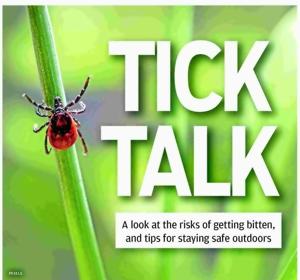
Warm weather entices you into the great outdoors. But while you're having fun golfing, camping, picnicking and hiking, ticks are looking for a ride — and a meal. Ticks live in woods, fields and grassy areas.
All of them survive on blood drawn from people or animals, and they can pass along disease in the process. To find their next meal, ticks climb onto objects like blades of grass, leaves or shrubs and stick out their legs. When a host brushes by, they grab on.

Some ticks attach quickly, while others wander, looking for places where the skin is thinner, like the ear. Ticks also like warm and dark areas, such as the armpit, behind the knee, along the scalp and in the belly button. That's where they'll grab hold and bite.
While attached to a host, ticks can acquire or pass along disease. After feeding, most drop off . At their next feeding, ticks can transmit an acquired disease to the new host.
Tick-borne diseases Ticks are found in most regions of the country. Here's a list of tick-borne diseases and the regions of the U.S.
in which they're common: Lyme disease, anaplasmosis, babesiosis and Borrelia miyamotoi disease: Upper Midwest and the Northeast Ehrlichiosis: Southeast and South Central Rocky Mountain spotted fever: North Carolina, South Central and Southwest Relapsing fever: Great Plains, Mountain West and West Coast Southern tick-associated rash illness, or Lone Star tick disease: East, Southeast and South Central, but spreading north Preventive measures 1 When outdoor activities take you into tick territory, wear shoes (not sandals), long pants tucked into your socks, a long-sleeved shirt, a hat and gloves. 2 Stick to trails when possible, and avoid walking through low bushes and long grass. 3 Keep dogs leashed so they don't venture where ticks may be.
4 Use insect repellents with at least 20% DEET. Repellents with up to 30% DEET can be applied to children over 2 months old but used sparingly on children under 2. Apply to clothes and exposed skin but not hands.
5 After spending time in a wooded or grassy area, check yourself, as well as your children and pets, for ticks. Deer ticks, which carry Lyme disease, often are no bigger than the head of a pin, so search carefully. 6 Shower as soon as you come indoors.
Using a washcloth on your skin can dislodge ticks that haven't attached yet. You also can put your clothes in the dryer for 10 minutes on high heat to kill lingering ticks. How to remove ticks If a tick has attached, time is key.
The longer it hangs on, the greater your risk of getting tick-borne diseases. To remove a tick: ■ Avoid folklore remedies like painting the tick with nail polish or petroleum jelly or using heat from a match or lighter to release its hold. ■ Use fine-tipped tweezers to grab the tick firmly near its head or mouth and as close to the skin as possible.
■ Pull the tick's body up and away from your skin. Avoid jerking or twisting. ■ Take a photo of the tick so your health care professional can identify it.
Dispose of the tick by putting it in alcohol or a sealed bag, wrapping it tightly in tape or flushing it down the toilet. ■After handling the tick, use soap and water to wash your hands and the area around the tick bite. When to see a doctor A small, red bump often appears at the site of a tick bite and resolves after a few days.
This is typical and doesn't indicate that it has transmitted a disease to that person. Contact your health care professional if: ■ You aren't able to completely re-move the tick. ■ The rash or bump gets bigger.
■ You develop flu-like signs and symptoms. ■ You think the bite site is infected. For more info, visit www.
mayoclinic.org . More about DEET The concentration of DEET in a repellent determines how long protection lasts.
A concentration of 10% provides two hours of protection; 30% gives five hours. Avoid products that combine sunscreen and DEET, because sunscreen needs to be applied more frequently than DEET. Get local news delivered to your inbox!.










